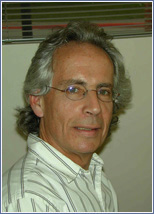|
 
Stanley Osher
members of the US National Academy of Science;
Professor of Department of Mathematics,
University of California Berkeley
Academic History
1977 每 Present Professor, Department of Mathematics, UCLA
1975 每 1977 Professor, Department of Mathematics, SUNY, Stony Brook
1970 每 1975 Associate Professor, Department of Mathematics, SUNY,
Stony Brook
1968 每 1970 Assistant Professor, Department of Mathematics, University
of California Berkeley
1966 每 1968 Assistant-Associate Mathematician, Brookhaven National
Laboratories
1966 New York University, Ph.D., (J.T. Schwartz, thesis advisor)
1964 New York University, M.S.
1962 Brooklyn College, B.S.
Research Interests:
Scientific Computing, Numerical Analysis, Applied Partial Differential
Equations
Honors:
Fulbright Fellow, 1971
Alfred P. Sloan Fellow, 1972-1974
SERC Fellowship (England), 1982
US-Israel BSF Fellow, 1986
NASA Public Service Group Achievement Award, 1992
Invited speaker, International Congress of Mathematicians, Zurich,
1994
ICI Original Highly Cited Researcher, 2002
Japan Society of Mechanical Engineers Computational Mechanics Award,
2003
ICIAM Pioneer Prize, 2003
Elected to US National Academy of Science, 2005
SIAM Ralph E. Kleinman Prize, 2005
Synergistic Activities
Dr. Osher is the coinventor and a principle developer of widely
used:
i) state-of-the-art high resolution schemes for approximating hyperbolic
conservation laws and Hamilton-Jacobi equations;
ii) level set methods for computing moving fronts involving topological
changes; applications and extensions include a variational version,
multiphase flow, crystal growth, computer vision and graphics;
iii) total variation and other partial differential equations based
image processing techniques.

Mathematics in the real world and the fake world
A good example of data centric computing involves a new approach to image science and free boundary problems in nature. This is exemplified by the level set method for capturing moving fronts, which was introduced in 1987 byOsher and Sethian. It has proven to be phenomenally successful as a numerical device. For example, typing in Level Set Methods on msn's search engine gives roughly 700,000 responses. Applications range from capturing multiphase fluid dynamical flows, to special effects in Hollywood to visualization, image processing, control, epitaxial growth, computer vision and many more. In this talk we shall give a quick overview of the numerical technology, its relation with the field of PDE-based imaging science and some application. The real world is exemplified by image analysis and the fake world by computer graphics.
A link to my web page comes from www.math.ucla.edu/~sjo
|
